THE FLUID STORY
Reprinted from "Crown Jewels of the Wire", February 2007, page 18
(Caution - LARGE DOWNLOAD)
Once the capital of the Territory of Oregon, Oregon City
governed an area that today makes up the states of Oregon, Washington, Idaho,
and the western portions of Montana & Wyoming. It was the "End of the
Trail"... THE destination for thousands of immigrants who in the 1840's
steered their covered wagons to the west and a better life. It was the hub from
which agricultural, industrial and economic enterprises spread throughout the
Pacific Northwest in the first half of the 19th Century. From this
entrepreneurial spirit arose new ideas about the transmission of electricity in
the 1880's.
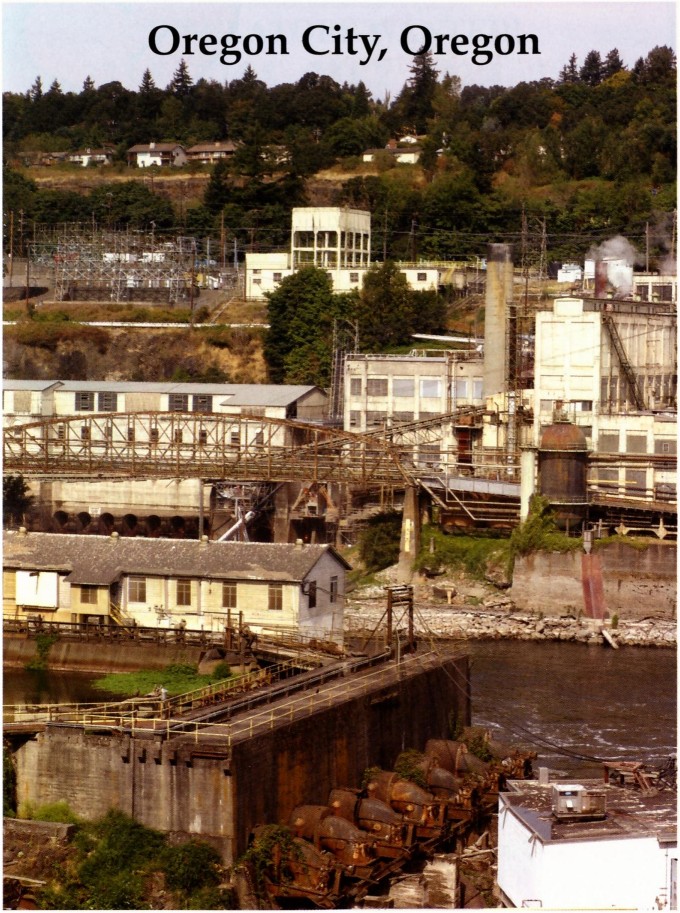
Hyas Tyee Tumwater, a 50-foot drop on the Wal-lamt (Willamette) River, has
attracted people from the ancient of times. Numerous tribes of Native Americans
gathered there for the annual migration of salmon over the falls. Hudson Bay
Company operative John McLoughlin established a land claim there 1829, having
recognized the economic potential of water power. In 1830, McLoughlin blasted a
mill race into the rock to power a sawmill. The falls have since been used to
supply water power for the manufacture of lumber, flour, woolen cloth, paper,
and electricity.
(page 18)

McLoughlin laid out a townsite near the falls that he called Oregon City in
1842. By the mid-1840's Oregon City was the Territorial Capitol of Oregon with
some 500 residents. The city boasted of several firsts for American cities west
of the Rocky Mountains, including the first newspaper (1846), first mail
delivery (1846), first jail (1845), first library (1845), first debating society
(1842), and of interest to readers of Crown Jewels, the first long-distance
transmission of electricity in North America (1889).
Not that electricity wasn't already in use around America in the 1880's. But
its distribution was restricted to short distances from the generating source,
usually covering an area of only a few city blocks. That was the case in many
cities, including Portland, Oregon.
Portland is located downstream from Oregon City. Founded in 1851, Portland
quickly became the region's largest city due to being located on the Columbia
River, which even then was navigable for ocean going vessels.
(page 19)
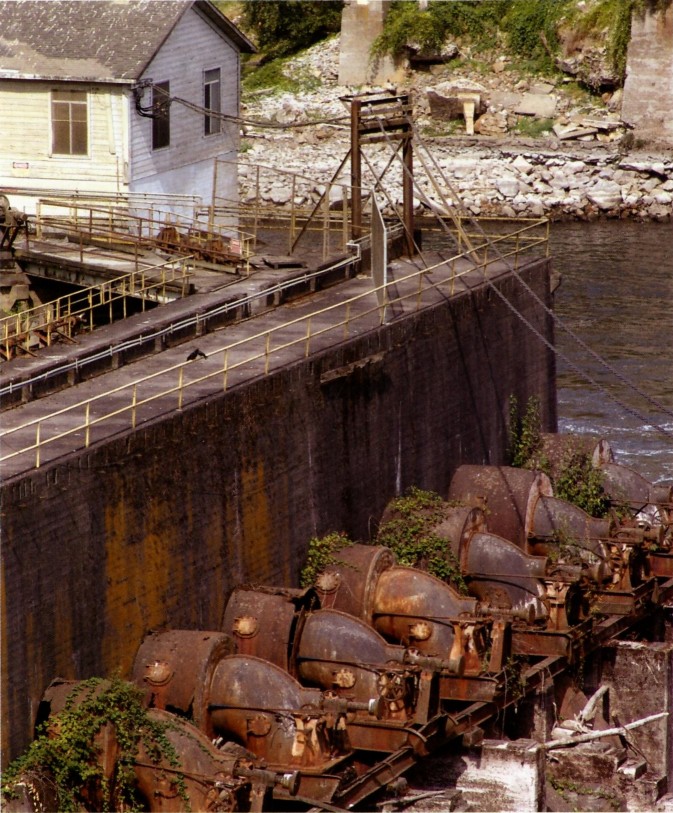
The steamship SS California introduced electricity to Portland in 1879, when it used its own engines to power an arc streetlight near the dock for three nights. The next year electric lights were installed at a sawmill, a sea food restaurant, and at the dock. Small steam engines and "dynamos" provided the power. Using this technology, a man named Parker Morey formed a company called the United States Electric Lighting and Power Company to power street lights in Portland starting in 1885.
Back in Oregon City, banker Edward Eastham envisioned using the water power of Willamette Falls to bring electricity to his city. In 1888, within days after a waterfall powered generator went into service, Eastham and Morey formed the Willamette Falls Electric Company with the idea of transmitting some of that power downstream to Portland.
(page 20)
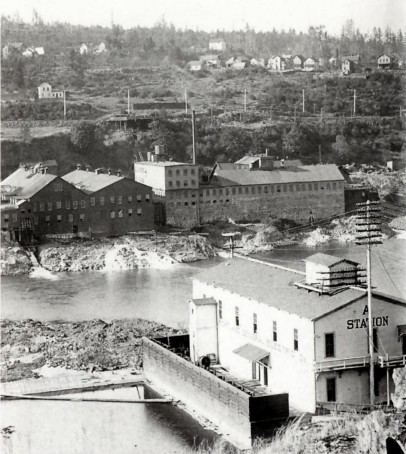 |
To the left is Power Station A as it looked ill the early 1890's.
The original building was destroyed by a flood.
The color picture on the previous page shows the backside of the site as it looks today.
Note the number of crossarms and large number of insulators.
Photo courtesy of the Clackamas Coun ty Historical Society |
But transmitting the power 14 miles from Oregon City to Portland would be no easy task. First, a dynamo house (generating plant) would have to be constructed within the river bed. A second, bigger, problem was how to construct a power line 14 miles in length. In 1889, no endeavor of that magnitude had ever been attempted in North America. What kind of insulators could be used? How much power could you transmit over a single wire?
The builders of the line took no chances on the power question, using multiple lines at low voltage to transmit the power. It would appear the original construction consisted of 18 wires per pole on three crossarms. Within a year, as the demand for power increased, three more cross arms of eight pins each were added. In the picture on the next page the second crossarm from the bottom only contains 6 insulators. That makes a grand total of 40 wires (and insulators) per pole for the 14 mile length of the line. If the poles were spaced 150 feet apart, then 490 poles were used for the 14 mile line. That means something in the neighborhood of 20,000 insulators were in use on the line by 1890. (Keep in mind, this is a power line and not a telephone or telegraph line.)
So what kind of insulators were they? Think about it, the cable groove used in so many power insulator styles wasn't patented until June 17, 1890... so you can rule out all of those styles. Determining insulator shapes from old photos can be difficult, but in the coming pages this article supports what many collectors have suspected for decades. It appears at least some of the insulators used are among the rarest in the hobby.
(page 21)
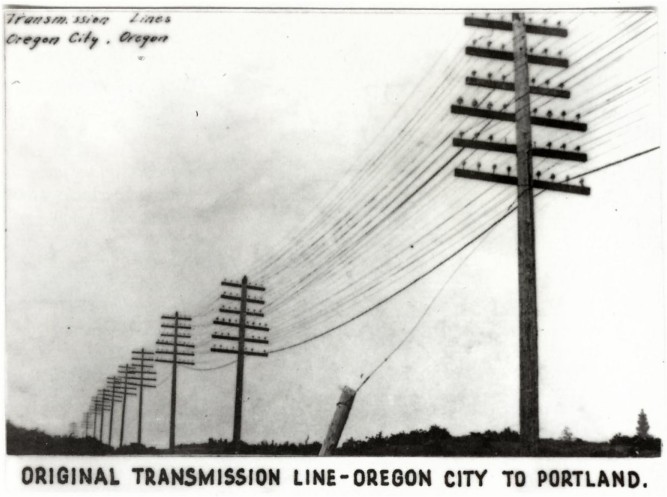
WHAT INSULATORS WERE USED?
It's obvious that a variety of insulators were used on the original line. The picture above, provided courtesy of the Clackamas County Historical Society, shows at least two different insulator profiles.
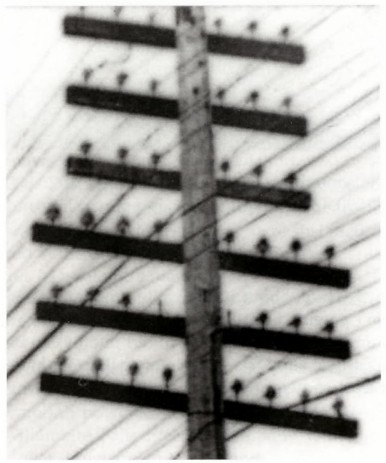 |
When the picture above is blown up, there's a significant loss in resolution.
Nevertheless, take note of the larger (wider) insulators in use on the third crossarm up from the bottom. |
(page 22)
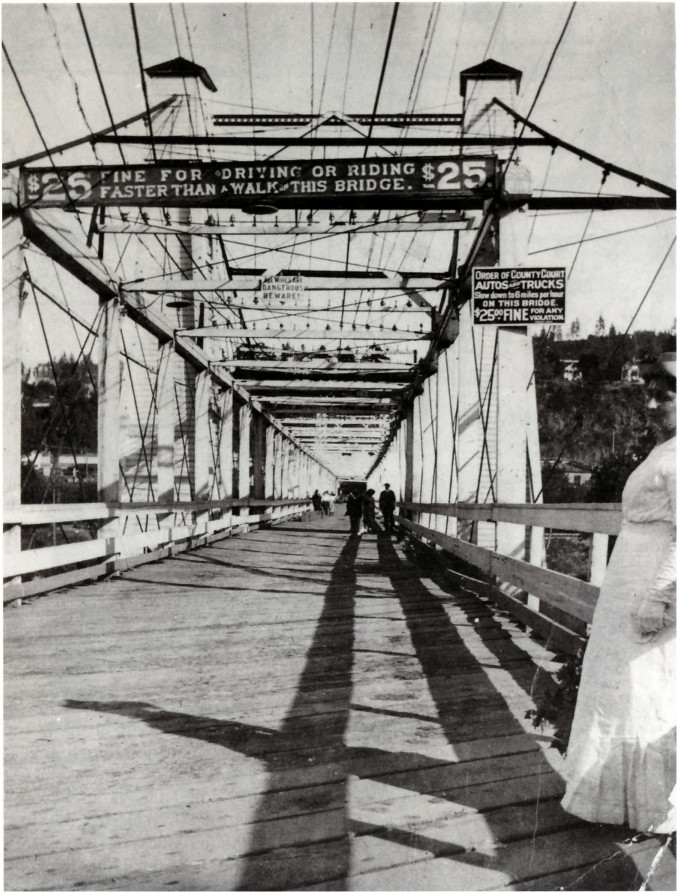
Power Station A was located on the east side of the Willamette River. Transmission lines ran first through downtown Oregon City before heading over this bridge and on to Portland. This picture, provided courtesy of the Clackamas County Historical Society, was taken in the early 1900's. Collector Mike Parker has a picture of this bridge that was taken in 1889 (see page 47). Mike's picture shows fuzzy images of many more insulators and wire than are in use here. And in Mike's picture, most if not all of the insulators appear to be this issue's "cover" insulator. Most of those had been replaced by the time this picture was taken, but not all. Take a look at the next page.
(page 23)
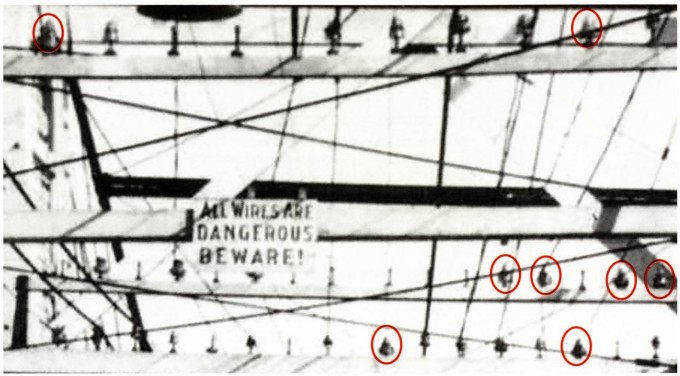
Liquids & Fluids
CD 180's embossed "Liquid Insulator", and CD 180.5's embossed "Fluid Insulator" have surfaced in the Portland area over the years. Not many. One reportedly at a garage sale, another at an antique show. The only confirmed find of one in use was made by Frances Terrill, the "Insulator By-lines" editor for Old Bottle Magazine more than 35 years ago.
Frances spotted a Liquid Insulator in Portland and had a lineman friend of hers remove it from service. It was pictured on the cover of her book, "Rare Insulators with Prices, Book One", and described one page 71 of the book. That book was published in 1970. She placed a value of $75 on the Liquid.
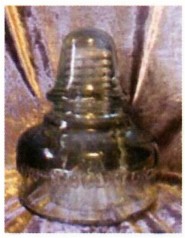
This Fluid Insulator (above) made quite a stir in the hobby I just a couple of years ago when it showed up on eBay. The National Insulator Association web site describes the event as follows: "A couple of non-collectors purchase a CD 180.5 Fluid Insulator for a few dollars, list it on eBay and sell it for over $10,000. The wire services pick up the story and the hobby sees an upswing in requests for appraisals, hits on insulator web sites, and more insulators listed on eBay, often with outlandish starting prices. The auction was mentioned on the "Paul Harvey" radio program!" So - great an interest in the hobby resulted from this eBay sale, that the number of subscribers to Crown Jewels magazine increased by almost 50 in the following two months. The insulator had been purchased in a shop on the Oregon Coast, about a hundred miles from Portland. Whether that insulator has any connection to Portland is unknown.
After viewing his photos, and the historic photos shown in this article, collector Mike Parker is convinced Fluids and Liquids were among the insulators used on the Oregon City to Portland line. Now for the story of our cover "girl".
(page 24)
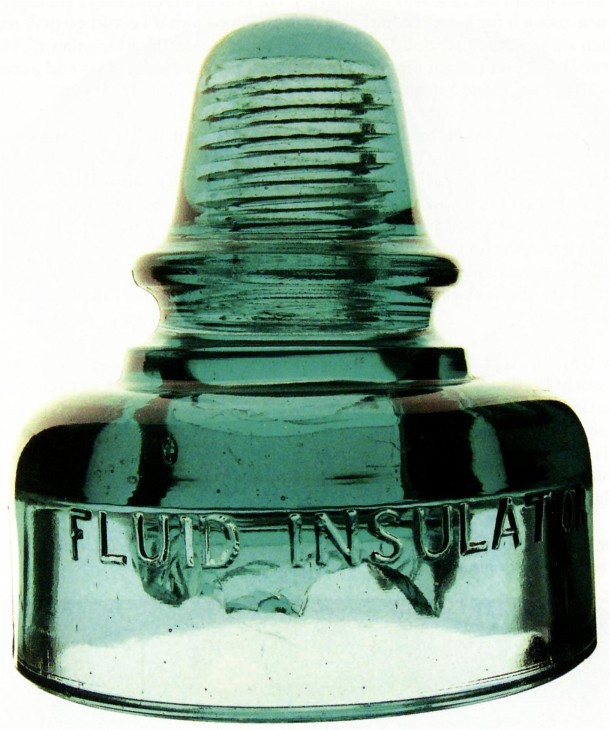
FLUID DISCOVERY
This CD 180.5 Fluid was found by a man hunting deer in the Oregon City area some forty years ago. Until recently, it was owned by collector Kurt Ogders, shown on the following page with his wife, Kelly. Here, in Kurt's words, is the story of this crown jewel:
"I have a fair amount of insulators in my collection, most given to me from my father, Scott Odgers. He collected back in the late '60's and early '70's before he acquired other hobbies. He was a lineman for Portland General Electric for 40 years, so had access to a lot of the great insulators Portland had to offer. I used to go to swap meets with him and helped him with his insulator lists.
"I was in middle school (called jr. high at the time) and we were studying electrical insulators in class. This would be around 1968
-1969. I brought in a basic CD 162 Hemingray to show the class. A friend of mine said he had an insulator that had the same top, but the base was much larger. His dad had found it on a hunting trip and was using it for a door stop to their attic. I asked him if I could go over to see it when we got out of school. To my amazement it was a "Fluid Insulator". I took it home and my dad about flipped! We took a few nice pieces of glass and a couple bucks over and made a deal with my friends father.
(page 25)
"I had seen a "Liquid Insulator" that Roy Gollihugh of West Linn, Oregon (Portland area) had at the time. And my Dad had "picked" a "Liquid Insulator" for the late Frances Terrill of Portland. She was an avid collector back then, and she had spotted the insulator on a pole in Portland. Her and my dad were good friends, and she trusted him. He was able to get the Liquid for her. I'm sure it's in some fine collection somewhere, as are many of the pieces he has had. He also was able to get a Westinghouse #2, many Mickey Mouse's, cables and other power insulators in the years the power company was changing out the old insulators for ceramics.
"Any way, I owned this Fluid Insulator for many years. I have been a lineman for 28 years in Portland for Qwest. About 15 years ago, with the help of Chuck Irwin of Portland, whom I used to work with before he retired from Pacific NW Bell, I was able to find the oil cup insert that compliments the Fluid. It had been broken and is glued together; it fits nicely under the Fluid. The main insulator is mint on the outside, but the inner skirt has been chipped pretty good. However, it does display really well".
Editor's Note: Roy Gollihugh sold his Liquid for $1,000 in the early 1970's. It is believed to have
been the first time any insulator sold for four figures.

(page 26)

Oil Cup for a Fluid
This is the oil cup mentioned by Kurt Ogders on the previous page. The oil cup contained the fluid for which the Fluid insulator was named. The idea was that if there was any electrical leakage over the surface of the glass insulator, it would end when it reached the oil. The concept probably worked well when the insulators and oil were new. When the line began transmitting power on the evening of June 3, 1889... the Oregonian newspaper reported, "It worked magnificently and conclusively demonstrated that our city can be lighted successfully from the falls. The result was a pleasing surprise to the company, the percentage of loss of electricity by transmission being less than their most sanguine expectations."
But once dust worked its way into the insulators and coated the fluid, the insulating values diminished. That may have been a contributing factor for why the line was completely rebuilt around 1894.
Oil cups appear to be even rarer than CD 180.5's. Crown Jewels was able to verify the existence of five Fluid's, and a few more are suspected of being in collections here or there. But only this and one other oil cup have been confirmed to us. The other example is in near mint condition, and was purchased at the 1990 National Insulator Show in... where else... Portland, Oregon. The example shown here was found by a bottle collector amid the shattered remains of a Fluid insulator that was beyond repair. The location of the dig is said to have been near Oregon City. It is likely the insulator's oil cup that caused the damage to the inner skirt of the Fluid shown two pages back.
(page 27)

The Fluid's Counterpart
The CD 180 Liquid Insulator was designed for the same function as a CD 180.5 Fluid. A reservoir of oil was designed to block electrical leakage to the pin. The difference between the two is that in the Liquid the oil reservoir is part of the insulator itself.
When Liquid's were formed, the glass worker turned the base of the insulator inwards and upwards to form a basin within the skirt of the insulator. Liquids are works of art, requiring skilled glass workers to manufacture them. But being finished by hand, they would have been slower and more expensive to manufacture.
A weakness in the CD 180 is that the oil basin is apt to be irregularly formed, thereby permitting dust to accumulate on the oil at a more rapid pace. Neither the
180 nor the 180.5 performed well over time, and were largely removed from service in the 1890's. Being ineffective, they were likely discarded rather than reused. Liquids are slightly smaller and more compact than Fluids, but are still a fragile insulator. Two or three times as many Liquid's exist compared to Fluid's, but its not known if more were made originally, or if they just survived better.
(page 28, Continued on page 43)
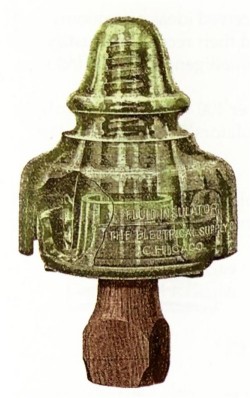 |
Who Made Fluids & Liquids?
While it is unknown what companies might have manufactured the CD 180 & CD 180.5, the Electrical Supply Company of Chicago advertised Fluids.
The picture at the left is a colorized version of the company's ad, taken from an 1892 catalog. The colorization was done by collector Simon Burson, and can be found at the following web address:
http:// www.insulators.com/ articles / fluid.htm
Below is the text from the Electrical Supply Company's advertisement. |
"The insulator supports of an overhead line are the vital points of importance to the insulator resistance of the entire line and those that are the most advanced in electric light and power work have learned from experience the economy of carefully insulating the line to prevent the leakage of current.
"The Fluid Insulators are especially designed to prevent surface leakage, and to give an insulator many hundred times higher than that obtained from the ordinary forms of glass insulators now in use. An insulating fluid, which is not sufficiently dense to support even a film of dust or moisture, is placed in a recess formed in the glass, and well protected from the weather. In this way a fluid surface, which is always clean and highly insulating, even in the dampest weather, is interposed between "line" and "earth." It can be readily observed that, although the first outlay for these insulators may be greater than that for ordinary glass insulators, the subsequent saving in running expenses and the avoidance of trouble will more than repay first expenses within a very short time.
"In power transmission, where it is desired to transmit heavy currents of high electro-motive force, the use of Fluid Insulators is an absolute necessity to success. In connection with this we would call attention to Prof. Badt's Electric Transmission Hand-book. The "Insulation Fluid" will not freeze, evaporate, nor creep like paraffine or mineral oils, and will last three or four years even in a hot climate. It is, therefore, advisable to use the Fluid intended for the insulator and not cheap substitutes.
"A conception of the value of Fluid Insulators may be gathered from the fact that at the present time they are in use all over the world by various governments, telegraph, telephone, and electric light and lower companies, but nevertheless, although foreign companies have been using them for over twelve years, and their insulator properties have become a matter or record, they have not heretofore been extensively adopted in the United States, principally on account of the less care used in these matters by the people in this country and their advance in price over those commonly in use. In placing them before the electrical public we appeal to the intelligence of the purchaser rather than to his preconceived ideas of economy, and feel confident that if these insulators are once adopted their record will justify our claims for their excellence and our confidence in the intelligence of the purchaser.
(page 43)
Experience has demonstrated that for pressures of over 400 volts the electric light purchaser can not afford to use any but the Fluid Insulators. The following test may be of interest:
"Twenty ordinary and twenty oil insulators were placed on poles in the usual manner, and during three years constant observations gave the following result:
|
20 Fluid Insulators 12.960 Megohms |
== |
each 259.2 Megohms |
| 20 ordinary insulators 0.222 Megohms |
== |
each 4.4 Megohms" |
Expensive Product
Fluid insulators were very expensive for their time. The Electrical Supply Company's ad priced them at $400 for one-thousand... or 40-cents apiece. But that was only the start. The insulators needed a special pin to support the oil cup, and the pins cost $50 per thousand. Then a spring cotter key was needed for the pin & oil cup, at an additional cost of $40 per thousand. And finally, you needed the fluid itself. Thirty gallons were required for one-thousand insulators, at a cost of $30. The total cost of using 1,000 Fluid insulators was $520... or 52-cents apiece.
By comparison, within a few more years Hemingray sold its CD 257 cable insulator for $155 per thousand, or 15-cents each. Standard pins were only a few cents apiece.
But notice that I said in a few more years. In the 1889-1890 period when Fluids and Liquids were installed on the line from Oregon City to Portland, there weren't many alternatives for effective power insulators.
Threaded Pin Type Scale Drawings: Shown below are the CD drawings as assigned by N.R. Woodward and pictured in McDougald's Price Guide. Note that the Fluid (right) is a somewhat larger insulator than the Liquid (left).
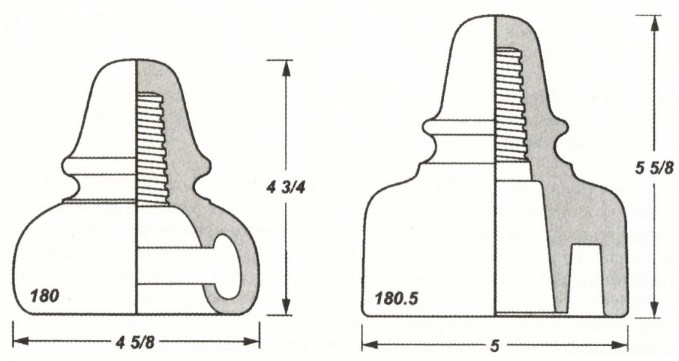
(page 44)
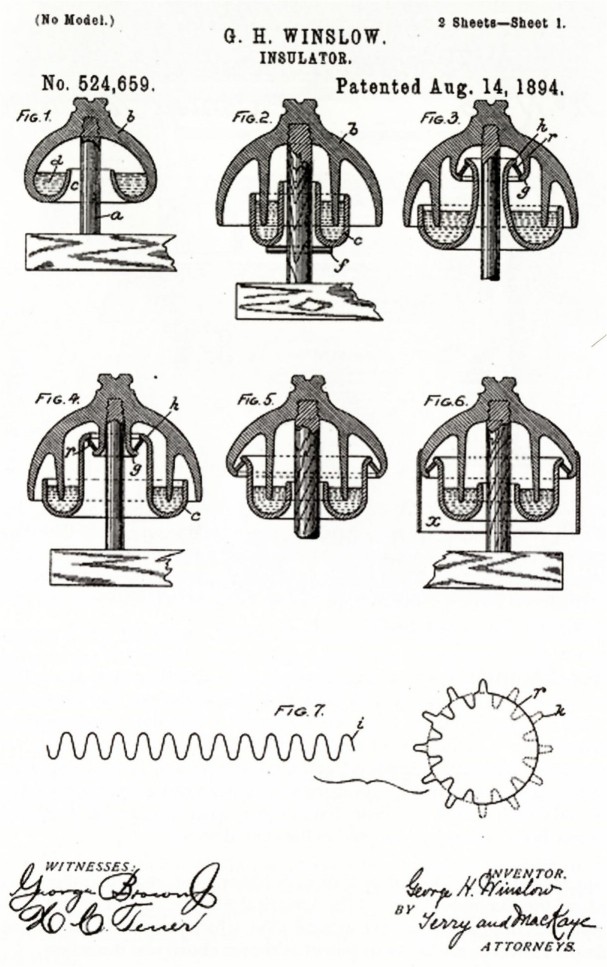
Winslow Patent: Figure one in the patent drawing resembles a CD 180 Liquid. Figure two is more like a 180.5 Fluid. Note that the patent was granted in 1894; while Fluids were advertised in the Electrical Supply catalog in 1892; and appear to have been placed in service on the Oregon City to Portland line in 1889.
(page 45)
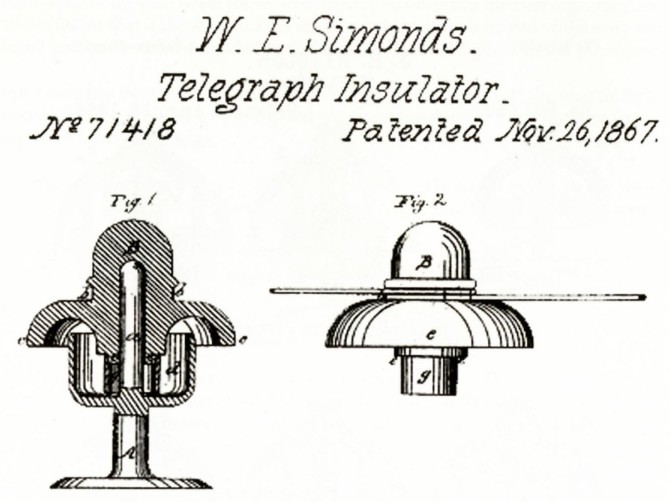
How do you explain the Winslow patent being issued perhaps as much as five years after Fluids & Liquids were in production? Could we speculate that Winslow didn't pay his patent attorney in a timely manner? Or perhaps several years went by before someone noticed that the concept wasn't covered by a US patent? Does that explain Winslow's shotgun approach showing six different figures for how the insulator could be designed?
Other Patents: The drawing above is of a British patent from 1867 by someone named W.E. Simonds. So let's also speculate about that insulator. The Electrical Supply Company, in its advertisement, wrote the following about the Fluid insulator: "...at the present time they are in use all over the world by various governments, telegraph, telephone, and electric light and lower companies, but nevertheless, although foreign companies have been using them for over twelve years, and their insulator properties have become a matter or record, they have not heretofore been extensively adopted in the United States...".
Our question, then, is: Does anyone own, or has anyone seen, an foreign insulator based on the Simonds patent? The Electrical Supply advertisement indicates the style was in production since around 1880, which would indicate a threaded insulator. However, the Simonds patent as shown above was threadless.
W. C. Johnson & S. E. Phillips received a patent on March 26, 1878 for an insulator with an oil basin. Their patent had applications for insulators used both above and below the crossarm. Their patent was intended as an "insulator for telegraph wires", rather than for the transmission of electrical power. No doubt the 1867 Simonds patent was intended for telegraph use also.
(page 46)
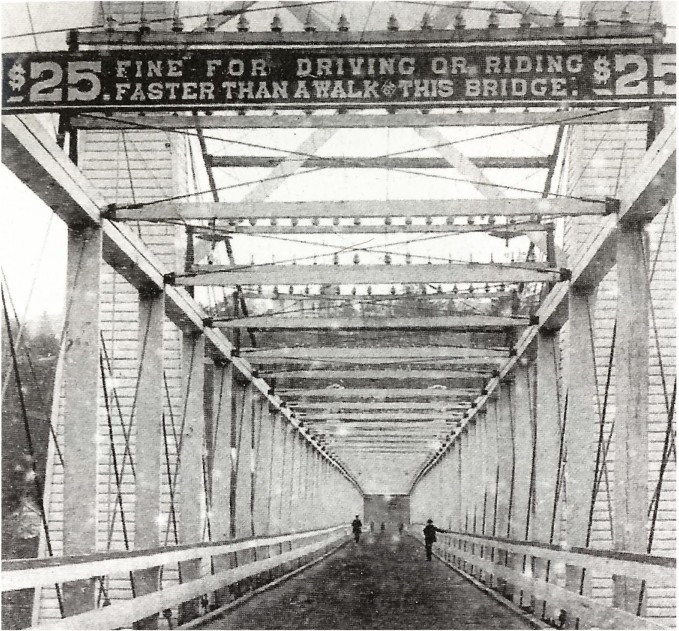
Oregon City Bridge - 1889. Shown above is Mike Parker's picture of the bridge over the Willamette River, which he believes was taken in 1889. While the quality of this print isn't as good as the picture taken in the early 1900's (shown on page 23), note that virtually every insulator above the sign looks like it could be a Fluid or a Liquid.
Mike wrote an article about the Oregon City to Portland line which was printed in the Fall 2001 issue of the Power Line Explorer Journal, which we recommended for those with further interest in this line.
One of the points Mike noted in the article is that when the line was converted from DC power to AC in 1890, George Westinghouse was personally persuaded to manufacture the unprecedented large alternators needed at Willamette Falls.
He agreed to make them with one stipulation... there would be no guarantee they would work.
Mike also noted in the article that the original line was rebuilt in the 1894-1897 period to a double 3-phase, 10,000 volt circuit, and installed on two sets of crossarms. He states that the rebuilt line used Fred Locke CD 289's, and some Hemingray CD 282 No.2 Provos. At this stage there were 12 insulators per pole instead of 40 as were used on the original line.
(page 47)
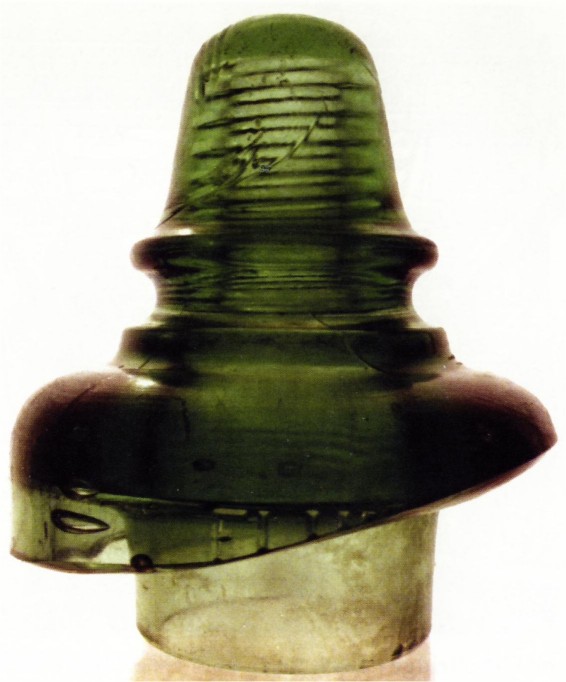
Fluid Colors
The damaged Fluid above demonstrates the unusual fact that CD 180.5's come in nearly as many different colors as there are examples known. Dwayne Anthony writes, "I have a damaged one that is a true medium green. It was dug out of a privy in Chino, CA. Another one in a light green was found at an estate sale in Chino Hills, CA (suburb of Chino). It was sold to the McDougald's who later resold it. I also have in my database that one was found in Oregon in light aqua, but no further specifics."
McDougald's Price Guide lists the following colors for Fluids: ice aqua, ice gray green, and green. All those colors are in sharp contrast to our "cover girl", which is a dark aqua color commonly found in Hemingrays.
Why so many different colors for so few insulators? Normally, that would indicate a large production run on different dates, with different batches of glass, over a period of time. So why aren't there more Fluids around? This is a case of "so many questions, so few answers".
(page 48)
Willamette Falls Electric Company
Here are additional facts about America's first long distance transmission line:
* The line used DC current when first constructed in 1889.
* The line went to AC current in 1890.
* Such large alternators were ordered that Westinghouse Company engineers at first refused to build them. They had to be capable of producing 4,000 volts.
* The initial purpose for the line was to light 55 street lamps in Portland.
* Customers paid about $2.50 per month for each 16 candlepower carbon lamp installed.
That was more than a day's wages for each light.
* When watt-hour meters were first installed, the price for power was 20-cents per kilowatt hour... equivalent to more than $4 per kilowatt hour in today's dollars.
* The name was changed to Portland General Electric in 1892 in hopes that having a name similar to General Electric would attract more investors.
* Station A, the original power house, was replaced by Station B (later known as the Sullivan Plant) which was built on the other side of the Willamette River in 1895. Station B, still operating today, can be seen in the left background of the picture on page 18.
* The transmission line was rebuilt in conjunction with Station B (1894-1895). CD 289 style insulators were found in service in the area in the 1960's, and some collectors feel they may have been introduced with the line reconstruction in the mid-1890's.
* The company paid its linemen $2.50 per day in the 1890's. But paydays were inconsistent; and one lineman complained he didn't get paid for seven months.
* One company rule said that if a lineman fell off a pole, his wages would be docked until he got back up again.
* To help create the demand for electricity, the company invested in the creation of an electric railway system for Portland.
* The company was a sponsor of the 1905 Lewis & Clark Worlds Fair in Portland, and dazzled the crowds with a display of 100,000 sparkling lights.
* The power company itself was a retailer in the early 1900's, selling irons, vacuum cleaners, toasters, percolators, razors, curling irons and other electric appliances.
* One-hundred years later, Portland General Electric survived the demise of Enron; and today continues to provide electric power to 775,000 retail customers using hydro and thermal generating facilities. A nuclear power plant built by the company a generation ago has been decommissioned; and the site is expected to be declared safe for other uses by 2008. The company today has annual revenues of almost l.5-billion-dollars, and generates over 18-billion kilowatt hours of electricity annually.
(page 49)
Conclusion
Can we say conclusively that Fluids and Liquids were among the insulators used
on the Willamette Falls Electric Company line? No. Is there circumstantial evidence they were used on the line? Yes.
Why have so few of the CD 180 & CD 180.5 insulators survived? I would suggest they simply were discarded as an
unsuccessful product. There was no reason for a power company to save or reuse them. I have not seen a detailed explanation of how the cotter pin fastened the CD 180.5 to its oil cup. But I would suggest that when dismantling a line of obsolete insulators it was too time
consuming to carefully remove the cotter pin.
Cross arms were likely just dropped to the ground and, during the impact, the cotter pins probably contributed to the destruction of both the oil
cup and insulator. Any comments or observations you have are welcome.
Howard Banks
Resources:
Bringing Power to Ideas, by Portland General Electric, 34 pages, 1989.
Hemingray Glass Company, by H.G. "Bea" Hyve, 481 pages, 1998.
http://www.endoftheoregontrail.org/road2oregon/sa27ORcity.html
http://www.nia.org/timeline/hobby.htm
http://www.weirdity.com/ebay/ebay-pictures-3.shtml
Insulators Price Guide, by John & Carol McDougald, 264 pages, 2003.
Multipart Porcelain Insulators, by Elton Gish, 378 pages, 200.
Power Line Explorer Journal, Vol. 3, No.1, Fall 2001
Rare Insulators with Prices, Frances Terrill, 108 pages, 1970.
www.insulators.com
www.portlandgeneral.com
Credits
Historic photographs provided by Mike Parker and the Clackamas County Historical Society.
When in Oregon City, plan to visit the Society's museum located on the bluff directly above the
remains of Power Station A. The museum has a display dedicated to the production of electric power.
Modem photographs by Barb Smith & Carver Mead, and by Howard Banks
Insulators shown in the article are owned by Barb Smith & Carver Mead, Ron Yuhas,
Dwayne Anthony & Howard Banks.
Contributing information: Kurt Odgers, Mike Parker, Dwayne Anthony, Ron Yuhas,
Simon Burson, Barb Smith & Carver Mead, Robin Harrison, Tim Wood, Bill Meier,
Paul Greaves & Elton Gish.
Color printing provided by Tommy Bolack.
(page 50)
|
